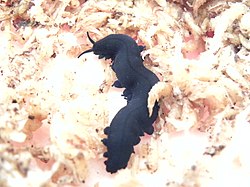Ecology and behaviour
Euperipatoides rowelli occurs in humid, temperate forests of southeastern Australia. Its main habitat are decaying logs on the forest floor, where it lives in crevices and feeds on small invertebrates, such as termites and crickets. [5] [6]
The preferred habitat of decaying logs is due to the fact E. rowelli are naturally attracted to darker objects. Because their rhabdomeric layer takes up the entire area inside of the eye, the focal point ends up being behind the retina, leading for the image that hits the retina to actually be underfocused. However, better spatial resolution is provided by the light emitted by the objects in front of them. This shows they are able to differentiate objects that are isoluminant with the background. [7] [8]
Specimens are rarely found alone, usually forming groups of a few individuals containing females, males, and juveniles. Laboratory observations on behavior concluded that these groups present some sort of hierarchy with dominant females. [6]
New logs are usually colonized by wandering males. The pheromones emitted by the first male to reach a log attract additional males, as well as females. It is assumed that males are attracted by other males because their high density increases the attraction of females. [9]
During reproduction, the male places its spermatophore on the female's skin. With the aid of the female blood cells, the body wall is breached and the sperm enters the female body cavity, then swims to the female genital tract. Females have two uteri and each one can have embryos at different developmental stages, up to six months apart, and from different males. [10] Males mature in about a year, while females can take up to three years. [11]
This page is based on this
Wikipedia article Text is available under the
CC BY-SA 4.0 license; additional terms may apply.
Images, videos and audio are available under their respective licenses.
